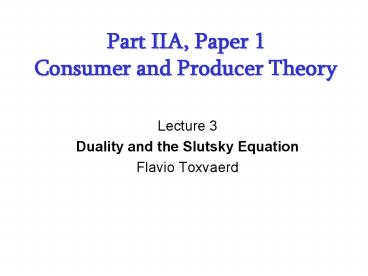Part IIA, Paper 1 Consumer and Producer Theory - PowerPoint PPT Presentation
1 / 25
Title:
Part IIA, Paper 1 Consumer and Producer Theory
Description:
Duality and the Slutsky Equation. Flavio Toxvaerd. Today's Outline ... Duality ... Duality in Demand Functions. We have shown that. Slutsky Equation. Income Effect ... – PowerPoint PPT presentation
Number of Views:782
Avg rating:5.0/5.0
Title: Part IIA, Paper 1 Consumer and Producer Theory
1
Part IIA, Paper 1Consumer and Producer Theory
- Lecture 3
- Duality and the Slutsky Equation
- Flavio Toxvaerd
2
Todays Outline
- Dual approaches to consumers problem
- Hicksian demand function
- Expenditure function
- Shephards lemma
- Slutsky equation
- The big picture (various relations)
3
Recap
Solve
Marshallian demand x1(p,m) and x2(p,m)
Substitute into u(x,y)
Roys identity
Indirect utility v(p,m)
4
The Envelope Theorem
5
The Envelope Theorem
6
Application 1 (again)
- Marginal utility of Income
The marginal utility of income is given by the
Lagrange multiplier
7
Application 2 (again)
- Roys Identity
8
Duality
Primal Problem
Dual Problem
x2
x2
x1
x2
9
Dual Problem
The dual problem gives us the minimum expenditure
required for the consumer to achieve a particular
level of utility.
First Order Conditions
10
Dual Problem
Eliminating the Lagrange multiplier (?) gives
MRS Ratio of Prices
Slope of Indifference Curve Slope of Budget Line
11
Hicksian Demand Function
- Solving these two equations, gives the levels of
demand which achieve the desired utility level at
the lowest cost - When indifference curves are strictly convex the
solution is unique and we may write demand as a
function of prices and the desired utility level
These are called Hicksian/Compensated Demand
Functions
12
Hicksian Demand Function
?(Hicksian Demand) Substitution Effect
13
Expenditure Function
We can now determine the minimum expenditure
required to achieve a specific utility level,
given the prices
14
Properties of the Expenditure Function
- Homogeneous of degree 1 in prices
- Proof No change in relative prices, so no change
in optimal solution - so expenditure changes by
same proportion. - Concave in prices
- Proof If prices change, expenditure will
increase linearly if consumption bundle
unchanged. Thus any change in consumption reduces
expenditure - and expenditure increases less than
linearly. - Increasing in prices if u(x) is an increasing
function
15
Shephards Lemma
16
Passive Expenditure
Indirect Effect
Actual Expenditure
(1) Will not do any worse than Passive
Expenditure
(2) As change in Px goes to zero, indirect effect
becomes irrelevant because original choice very
close to optimal
17
Indirect Utility and Expenditure Functions
- Recall Indirect utility function gave us the
level of utility given prices and income - Expenditure function gives us level of income
required to achieve a specified utility level - Thus the indirect utility function is just the
inverse of the expenditure function - and vice
versa
18
Duality in Demand Functions
u0
x2
e0
x1
So, we can write
19
Slutsky Equation
We have shown that
Slutsky Equation
Income Effect
Substitution Effect
20
Primal Approach
Dual Approach
Duality
Integrability problem
Solve
Solve
Marshallian Demand x1(p,m) and x2(p,m)
Hicksian Demand
Equivalent if
Substitute into cost equation
Substitute into u(x,y)
Roys Identity
Shephards Lemma
Indirect Utility v(p,m)
Invert
Expenditure Function
21
Integrability Problem
- The problem with all of this is that the utility
function is not observable - only behaviour
(demand) is observable - Thus we are in danger of having a wonderfully
elegant theory of consumer behaviour - which
relies on an unobservable function! - The Slutsky equation is defined for every
price/commodity combination
22
Integrability Problem
- The nice assumption of convexity and more is
better on the utility function impose
restrictions on the nature of the matrix of
Slutsky equations - These conditions turn out to be both necessary
and sufficient for the demand function to be
generated by a utility function which possesses
these nice properties. - Thus we can now identify precisely whether or not
our theoretical framework is appropriate
23
Summary
- Can approach consumers problem from different
angles - Having one function, may recover other functions
24
Readings
- Varian, Microeconomic Analysis, chapters 6, 7, 8
25
Next Time
- Revealed preferences
- WARP, SARP, GARP
- Indices

